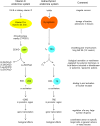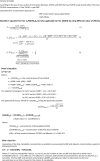Vitamin D Binding Protein: A Historic Overview
- PMID: 31998239
- PMCID: PMC6965021
- DOI: 10.3389/fendo.2019.00910
Vitamin D Binding Protein: A Historic Overview
Abstract
Vitamin D and all its metabolites are bound to a specific vitamin D binding protein, DBP. This protein was originally first discovered by its worldwide polymorphism and called Group-specific Component (GC). We now know that DBP and GC are the same protein and appeared early in the evolution of vertebrates. DBP is genetically the oldest member of the albuminoid family (including albumin, α-fetoprotein and afamin, all involved in transport of fatty acids or hormones). DBP has a single binding site for all vitamin D metabolites and has a high affinity for 25OHD and 1,25(OH)2D, thereby creating a large pool of circulating 25OHD, which prevents rapid vitamin D deficiency. DBP of higher vertebrates (not amphibians or reptiles) binds with very high affinity actin, thereby preventing the formation of polymeric actin fibrils in the circulation after tissue damage. Megalin is a cargo receptor and is together with cubilin needed to reabsorb DBP or the DBP-25OHD complex, thereby preventing the urinary loss of these proteins and 25OHD. The total concentrations of 25OHD and 1,25(OH)2D in DBP null mice or humans are extremely low but calcium and bone homeostasis remain normal. This is the strongest argument for claiming that the "free hormone hypothesis" also applies to the vitamin D hormone, 1,25(OH)2D. DBP also transports fatty acids, and can play a role in the immune system. DBP is genetically very polymorphic with three frequent alleles (DBP/GC 1f, 1s, and 2) but in total more than 120 different variants but its health consequences, if any, are not understood. A standardization of DBP assays is essential to further explore the role of DBP in physiology and diseases.
Keywords: 1,25-dihydoxyvitamin D; 25-hydoxyvitamin D; actin; megalin; vitamin D; vitamin D binding protein (DBP).
Copyright © 2020 Bouillon, Schuit, Antonio and Rastinejad.
Figures






Similar articles
-
Vitamin D and DBP: the free hormone hypothesis revisited.J Steroid Biochem Mol Biol. 2014 Oct;144 Pt A:132-7. doi: 10.1016/j.jsbmb.2013.09.012. Epub 2013 Oct 4. J Steroid Biochem Mol Biol. 2014. PMID: 24095930 Free PMC article. Review.
-
Vitamin D-binding protein directs monocyte responses to 25-hydroxy- and 1,25-dihydroxyvitamin D.J Clin Endocrinol Metab. 2010 Jul;95(7):3368-76. doi: 10.1210/jc.2010-0195. Epub 2010 Apr 28. J Clin Endocrinol Metab. 2010. PMID: 20427486 Free PMC article.
-
Vitamin D Binding Protein, Total and Free Vitamin D Levels in Different Physiological and Pathophysiological Conditions.Front Endocrinol (Lausanne). 2019 May 28;10:317. doi: 10.3389/fendo.2019.00317. eCollection 2019. Front Endocrinol (Lausanne). 2019. PMID: 31191450 Free PMC article. Review.
-
Opposite correlation of 25-hydroxy-vitamin D- and 1,25-dihydroxy-vitamin D-metabolites with gestational age, bone- and lipid-biomarkers in pregnant women.Sci Rep. 2021 Jan 21;11(1):1923. doi: 10.1038/s41598-021-81452-9. Sci Rep. 2021. PMID: 33479299 Free PMC article.
-
Calculated free and bioavailable vitamin D metabolite concentrations in vitamin D-deficient hip fracture patients after supplementation with cholecalciferol and ergocalciferol.Bone. 2013 Oct;56(2):271-5. doi: 10.1016/j.bone.2013.06.012. Epub 2013 Jun 20. Bone. 2013. PMID: 23792937 Clinical Trial.
Cited by
-
The plasma free fraction of 25-hydroxyvitamin D3 is not strongly associated with 25-hydroxyvitamin D3 clearance in kidney disease patients and controls.J Steroid Biochem Mol Biol. 2023 Feb;226:106206. doi: 10.1016/j.jsbmb.2022.106206. Epub 2022 Oct 28. J Steroid Biochem Mol Biol. 2023. PMID: 36404469 Free PMC article.
-
Vitamin D3 Metabolism and Its Role in Temporomandibular Joint Osteoarthritis and Autoimmune Thyroid Diseases.Int J Mol Sci. 2023 Feb 17;24(4):4080. doi: 10.3390/ijms24044080. Int J Mol Sci. 2023. PMID: 36835491 Free PMC article. Review.
-
Radioprotective Role of Vitamins C and E against the Gamma Ray-Induced Damage to the Chemical Structure of Bovine Serum Albumin.Antioxidants (Basel). 2021 Nov 24;10(12):1875. doi: 10.3390/antiox10121875. Antioxidants (Basel). 2021. PMID: 34942979 Free PMC article.
-
Role of Vitamin D in Cognitive Dysfunction: New Molecular Concepts and Discrepancies between Animal and Human Findings.Nutrients. 2021 Oct 20;13(11):3672. doi: 10.3390/nu13113672. Nutrients. 2021. PMID: 34835929 Free PMC article. Review.
-
Serum Vitamin D Levels Explored in the Latvian Cohort of Patients with Basal Cell Carcinoma Linked to the Sonic Hedgehog and Vitamin D Binding Protein Cutaneous Tissue Indices.Nutrients. 2022 Aug 16;14(16):3359. doi: 10.3390/nu14163359. Nutrients. 2022. PMID: 36014865 Free PMC article.
References
-
- Thomas WC, Morgan HG, Connor TB, Haddock L, Bills CE, Howard JE. Studies of antiricketic activity in sera from patients with disorders of calcium metabolism and preliminary observations on the mode of transport of vitamin D in human serum. J Clin Invest. (1959) 38:1078–85. 10.1172/JCI103884 - DOI - PMC - PubMed
Publication types
Grants and funding
LinkOut - more resources
Full Text Sources
Other Literature Sources
Miscellaneous

